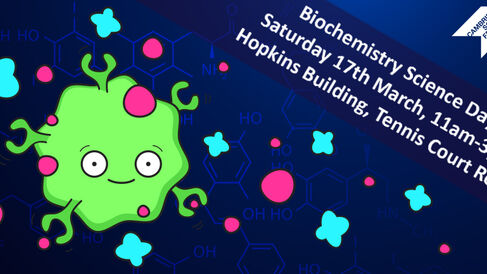
How Cells Sense the World. 11am-3pm, Saturday 17th March. Hopkins Building, Tennis Court Road, Cambridge, UK.
The different cell types in our body and brain help us sense the world around us. As part of the Cambridge Science Festival, visit our Department and become a scientist for the day to discover how we and our cells see light, detect smell and make sense of the world around us. This interactive event includes hands-on experiments, informative demonstrations and plenty of fun activities for children and adults of all ages!
Hands-on experiments and demonstrations
- Taste:
We will be investigating the effect of the 'miracle berry' on the taste of lemons and malt vinegar! The miracle berry contains an acid-sensitive protein, miraculin, that binds a sweet receptor on the tongue so that everything acidic tastes sweet. Sweet!
- Smell:
Can you tell your oranges from your lemons? Our noses distinguish stereoisomers to give us a clue, but see if you can tell oranges from lemons, when blindfolded, from their smell alone.
- Sight:
How do we see? Light activates receptors in the eyes, but different people see differently because they have different receptors. Come and test whether your light receptors are up to scratch.
- Sound:
How do the 'hairs' in your ear help you hear? How does your skull help too? Take part in our unusual experiment to find out how you would cope if your ears switched around.
- Touch:
Pain isn't pleasant, but it has its uses. Join Dr Tony Jackson as he explores the world of pain in our informal talks at 12pm and 2pm. See below for details.
- The science of separation:
Biochemists need to isolate all sorts of things, including the receptor proteins and signals involved in our senses, to enable research on specific topics. We will explore how this separation technique is used in the lab via a hands-on experiment.
- Eat-me, don't-eat-me:
Our cells have 'eat-me' or 'don't-eat-me' signals on their surface so that other cells can sense whether to eat them or not. Try it out for yourself in our game, where if you lose, you get eaten!
- Do you have what it takes to be a white blood cell?
Can you capture the most baddies and be top of our leader board? In this demonstration you can become a white blood cell and zoom around on wheels capturing bacteria.
- DNA damage detectors:
The genetic information encoded in our DNA is very precious. DNA is a stable molecule, but it can be damaged by dangerous chemicals present in alcohol and cigarette smoke. Come and see our molecular graphics, showing how our cells' own team of protein engineers sense, inspect and fix any damage to our DNA.
- Brains in action:
Come and see brain cells under a microscope, and watch them glow as they sense a new chemical in their environment.
- Brain hats:
Have you ever wanted to make a new brain for yourself? Well now is your chance! We will be making new brains from scratch, and you can wear the product as a brain hat.
- Arts and crafts:
How do we view all the receptors and signals that cells use to sense the world around them? Fluorescence microscopy is answer! Relax with a tea and channel your inner artist to produce some fluorescent artwork of model organisms to take away with you.
Talks
Throughout the day we have a number of formal and informal talks open to everyone.
- Pain: How to start it and how to stop it
Pain seems like a pain in the neck, but people who can't feel pain easily damage themselves. In this short talk we explore the world of pain, how to start it, and how to stop it.
Location: Seminar Room, Hopkins Building
Time: 12pm and 2pm
Duration: 20 minutes
Registration: Not required, but seating is limited and will be allocated on a first-come first-served basis
- Pop-up presentations
Our researchers and students will be giving various pop-up talks about their work spontaneously during the day.
Location: Look out for the soapbox in the foyer
Time: All day, but spontaneous
Duration: 3-5 minutes
Registration: Not required
Social media
To keep up-to-date with all our news for the Science Day, see how things are prepared behind the scenes, and watch our live stream if you can't make it down to Cambridge to visit us, give us a follow on Facebook, Twitter and Instagram (@CamBiochem).
We'll be using the hashtags #BiochemDay18 and #CSF2018.
How to find us
Click here for details of how to get to the Hopkins Building. Information on the accessibility of the Department can be found here.
